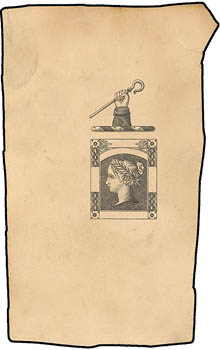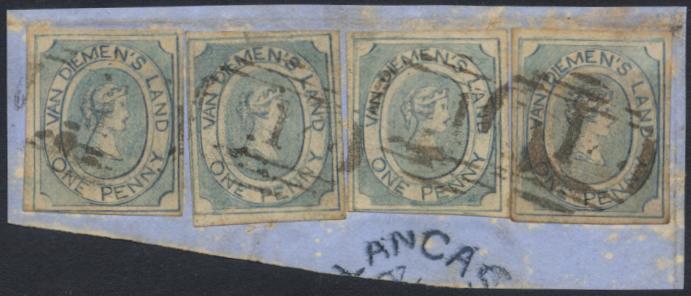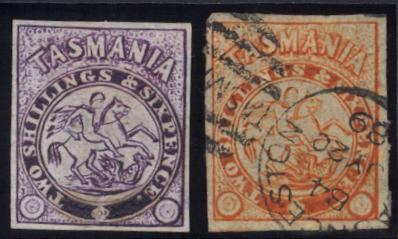
Forged 'TWO CENTS' overprint sold by Benjamin and Sarpy (image obtained from a Prestige Philately Auction no. 132, Dec 01, 2007).
Return To Catalogue - Jeffreys, Benjamin and Sarpy trial - Benjamin (stamp forger)
Note: on my website many of the
pictures can not be seen! They are of course present in the cd's;
contact me if you want to purchase them: evert@klaseboer.com.
Jeffreys (George Kirke) was a forger in the late 19th century (London). According to 'Philatelic forgers, their lives and works' (by Varro E. Tyler), his name is also sometimes spelled as: Jeffreyes, Jeffries or Jeffryes. He made some forgeries of overprints of various countries and forgeries of the following countries: Ceylon, Grenada, New South Wales, New Zealand, Tasmania and Victoria. Finally he made two bogus stamps of Hawaii. If anybody has more information about these forgeries, please contact me! More information about Jeffreys himself can be found at: http://www.ukphilately.org.uk/bpt/whowaswho/whowaswho-ijk.htm. He seems to have collaborated with the stamp dealers Alfred Benjamin and Julian Hippolite Sarpy (Benjamin and Sarpy), who sold many of his products in their shop.
In 1892 Jefrreys was convicted to six months imprisonment with hard labour for 'conspiracy to defraud the public' for his stamp forging activities.
The London Philatelist of 1892 (page 61) mentions that Benjamin and Sarpy sold forged Baden stamps (18 kreuzer), Bavaria 12 kreuzer (perforated) and Ceylon 9 p forgeries. Also mentioned are cleaned up Orange Free State stamps.
'Philatelic forgers, their lives and works' mentions that forged overprints exist of the countries: Colombia, Ecuador, North Borneo ('8 cents' on 2 c), Sarawak, Sungei Ujong and Zululand. He was exposed by J.B.Moens in 1883 for making bogus surcharges on Ecuador and Colombia stamps.

Forged 'TWO CENTS' overprint sold by Benjamin and Sarpy (image
obtained from a Prestige Philately Auction no. 132, Dec 01,
2007).
A very rare provisional surcharge 'TWO CENTS' (in
one line) on 3 c of Sarawak exists and was issued in 1874. After
some forged dies were found with the London forgers Benjamin,
Sarpy and Jeffreys with this surchage, it was believed that this
issue was bogus altogether. It is now believed that there
actually existed a genuine surcharge. By the way, any such stamp
with cancel 'SARAWAK P.O' in a box is a forgery made by the above
three gentlemen. The above mentioned Prestige Philately Auction
also mentions that "W. Batty-Smith in the London
Philatelist (Nov-Dec 1989) provided evidence supporting the
existence of a genuine 2c Provisional for use on newspapers".
More on the subject can be found at: http://members.fortunecity.com/borneo/swk-stp.htm
(an image of another forgery with the same boxed 'SARAWAK P.O'
and the red 'LONDON' cancel can be found there as well). This
website also shows a copy of a supposedly genuine 'TWO CENTS'
overprint; it is 17 mm long (the forgery shown above is 16 mm
long).
Forgery of the 1 Sh 9 p:
The best way of distinghuishing this Jefferies forgery (according to Brian Hicklings) is the lower part of the amphersand (&) which is much too large on the forgery. Also the 'O' in 'CEYLON' is larger in the forgery and is not out of line (due to its size) with the 'L' as in the original. This is a dangerous forgery. A picture of this forgery can also be found in 'Philatelic forgers, their lives and works' (there with overprint 'SPECIMEN').


(Grenada forgery, front and backside)

Probably a Jeffreys forgery of the 'TWO POUNDS' overprint, the
cancel is 'A GRENADA AU 29 89' in a single circle.
The above stamp is a Grenada forgery. Note the appearance of parts of adjoining stamps. Jeffreys forged the basic fiscal stamp to which he also applied forged 1/2 p, 2 1/2 p, 4 p and 1 Sh overprints. In addition to this he made some bogus 1 Pound, 2 Pounds and 5 Pounds fiscal overprints. These forgeries were made around 1885 to 1890. More information about these forgeries can be found at: http://www.bwisc.org/50_bulletins/b137_198806/b137_198806.pdf. The 4 p forgery exists with forged cancels with dates 'MR22', 'AU26' or 'JU19'. The 1 Pound forgery exists with '27NO' forged cancel and the 5 Pounds with 'JU26' or 'JU28' forged cancels.

(Jeffreys forgeries with '49' cancel of Wagga-Wagga)
The Jeffreys forgeries are engraved and dangerous, but they do not show the plating characteristics. Note the typical diamond pattern in the sides. They were printed in pairs. According to 'Philatelic Forgers, their Lives and Works' by Varro E. Tyler they exist either cancelled with the Sydney barred cancellation or the numeral cancels '43', '12', '24', '29', '34', '49', '62', '64', '84', '93' or uncancelled. But I've also seen them with cancels '38' and '92':

Jeffreys forgery with '84' cancel
The Philatelic Record of 1891 (pages
128-129) writes regarding forgeries of New South Wales (I presume
these are the above Jeffreys forgeries):
Mr. Castle writes as follows : "I have now had time and
the opportunity, thanks to a leading firm in London, to examine
the forgeries of the Sydney Views, to which I called the
attention of your readers last month. I have heard that in
addition to the Id. value, the 2d. and 3d. have also been
imitated, but have not yet seen them. I know of several cases in
which collectors and dealers have been 'taken in' by these clever
imitations, and can only express the hope that until the sale of
these counterfeits has been stopped intending purchasers of
"Views" will take the trouble to compare them with the
autotype plates, when they can readily ascertain their
authenticity or the reverse. I cannot, I think, do better than
repeat the description for the Record that I have already sent to
one of its respected contemporaries. "The Id. Sydney Views
submitted to me for inspection, are undoubtedly bad, but are
forgeries of so dangerous a character that, in the interests of
collectors, I think it advisable to point out such points of
variation as I have observed in a cursory inspection. Impression:
The stamps in question, which purport to be from Plate I.
(without clouds) in an early state of the die, are printed in too
rosy pink a shade, the colour approximating to this only
appearing in the real stamps with later printings ; while the
whole appearance of the stamps has a somewhat scratchy look,
notably in the outer diagonally-barred spandrils. The pick in the
foreground is almost vertical, whereas it should in all the types
slant at an angle of about 45 degrees to the right. In the real
stamps the upright vertical 'diamonded' border that appears right
and left, and is intersected by the vignette, consists really of
a lattice pattern, in which frequently more than one complete
diamond appears horizontally, sometimes part of two, and they are
of very irregular formation. In these forgeries the diamonds are
larger, more regularly shaped, and occupying the centre in each
case, impinge on both sides of the vertical band in which they
appear, being thus necessarily each directly above the other. The
most salient point of difference, I should say (noting however
that the word 'NOV.' in the border begins in both stamps exactly
opposite the foot of the central design), is the background of
the vignette. The true types have some few bold lines in the
foreground, indicating terra firma, for the figures to rest upon,
the middle distance is faintly lined, and allows the figure
ploughing to be clearly distinguishable, while the sea to the
right consists of a few lines quite detached from the rest. In
these imitations the whole of the background consists of straight
lines, principally equidistant, giving the appearance that the
figures—the (very indistinct) plougher—and the ship all
have a precarious footing on a watery medium that extends to the
foot of the hill. The two false types submitted differ from each
other in the other details, and are apparently engraved in
tailledouce (possibly all the 25 types have been done!), hence I
can best warn collectors by stating the common differences
between them and the originals. Paper.—This a thick, smooth,
slightly surfaced yellowish wove, shewing the granulations
clearly, and quite different from any of the many varieties on
which the genuine stamps exist. It most resembles the hard paper
on which the latest copies are found, but by comparison will be
seen to vary even from this; while, as is well known, all the
early impressions, such as these purport to be, are on a soft,
yellowish, spongy paper. Postmark: This is also done in a fainter
and more watery-looking medium than usually found, and the
obliteration, which consists of a vertical row of curved strokes,
with three diminishing horizonal bars above and below, is
slightly more spread and clumsier than the true postmark. "A
second and, if possible, more dangerous forgery is that of the
Id., Type II., with clouds, which would deceive even the
initiated, without the most careful scrutiny. I have before me a
strip of four, all different types—probably a row was
engraved of each plate—in which the colour approximates to
the 'original'; and the paper is somewhat thinner, smoother, and
more granulated than it should be. As in the preceding 'stamp,'
the diamonds are single, and each above the other in the vertical
column; the words 'camb. aust. sigillum' occupy the same relative
positions, 'NOV.' beginning uniformly at the base of the design,
where it is separated from the inscription; the pick and shovel
are as before, and they have (perhaps to a less extent) the
general scratchy appearance. The background is again watery,
consisting of straight lines ; the ship is too far away from the
edge, the clouds are too shaky and detached, and the bale has a
distinctly double-lined cross dividing it. The postmark consists
of curved bars right and left, and four diminishing horizontal
strokes above and below—somewhat thinner and more
greasy-looking than the proper cancellation. As a whole they are
exceedingly clever, and might deceive any one who had not the
types at command. I warn all collectors, therefore, against them,
and trust that the miscreants who make them may meet their due
reward."

Jeffreys 'proof'?

I've been told that this is a Jeffreys forgery, I have no further
information.

(New Zealand forgery, reduced size)

('Proof' of the 1 Sh stamp of New Zealand, note the hand with the
'staff' above the design)
The above stamps are forgeries of New Zealand. Note the appearance of parts of adjoining stamps.
A forged 'TWO CENTS' surcharge on a 3 c stamp (supposed to be a very rare provisional issue of 1874) was forged by Jeffreys as well (see above for image). It caused collectors to believe that this whole issue was bogus.

(Forgeries of the 1 p 1853 issue)


(2 Sh 6 p postal fiscal in violet, orange and red)


(Jeffreys forgeries of the 2 p and 3 p 1850 issue)
It seems that whole sheets of the 3 p forgeries were sold by the Royal Philatelic Society of Victoria in 1959 (source 'Philatelic Forgers, their Lives and Works' by Varro E. Tyler).

(Jeffreys forgery of the 1 Sh stamp)


(Left Jeffreys forgery, right official reprint for comparison)
Note that the letters of the inscription are slightly different in the Jeffreys forgery.
A bogus issue made by Jeffryes in 1886 for Hawaii, resembling the statue of Kamehameha.

(This stamp has cancel 'HONOLULU JUN 5 1886 H.I.')
A value of 2$ red in the same design exists as well.
In the London Philatelist of 1892 (page 29),
the following text can be found concerning these stamps (from the
court case of Jeffreys):
Henry Thomas Pauncefort, printer and engraver, of 16, Little
New-street, said that in August, 1886, a person named Jeffreys
came to his shop and gave him an order to engrave two steel
plates from designs given to him by Jeffreys. He engraved the
stamps produced The two plates were the same except as to the
number. He printed 1,000 from each plate. One was in blue and the
other in carmine. There was now what purported to be a postoffice
obliterating mark on the stamps. They were not there when he
executed the order. He was paid £3 15s. for the plates and £1
9s. for the 2,000 impressions. He did not know for what purpose
the stamps were intended. By Mr. Purcell : His business was
established in 1816 by his father, and witness had been 21 years
in business. He had never before or since printed fac-similes of
stamps. He thought it was for something ecclesiastical.
(Laughter.) By Mr. Jones : He would not swear that the two stamps
produced were two of those he printed. He printed them separately
and had nothing to do with the perforation. Both were Sandwich
Islands stamps.
For the Jeffreys, Benjamin and Sarpy trial, click here.